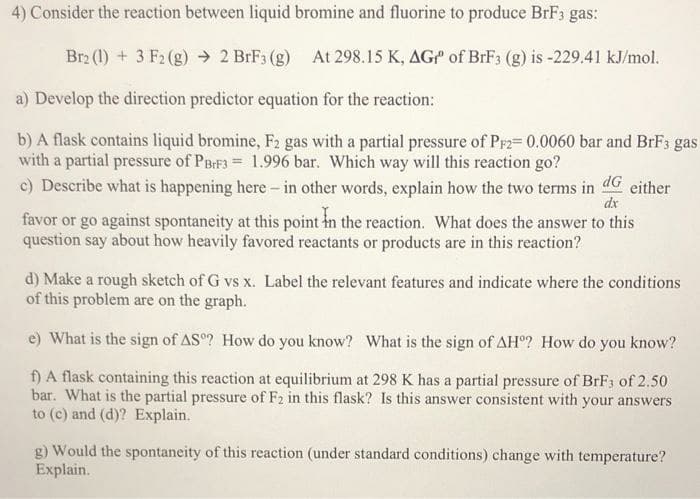) Consider the reaction between liquid bromine and fluorine to produce BrF3 gas: Br2 (1) + 3 F2 (g) → 2 BrF3 (g) At 298.15 K, AGP of BrF3 (g) is -229.41 kJ/mol. a) Develop the direction predictor equation for the reaction: b) A flask contains liquid bromine, F2 gas with a partial pressure of Pr2= 0.0060 bar and BRF3 ga= with a partial pressure of PBaF3 1.996 bar. Which way will this reaction go? c) Describe what is happening here- in other words, explain how the two terms in dG either dx favor or go against spontaneity at this point in the reaction. What does the answer to this question say about how heavily favored reactants or products are in this reaction?
) Consider the reaction between liquid bromine and fluorine to produce BrF3 gas: Br2 (1) + 3 F2 (g) → 2 BrF3 (g) At 298.15 K, AGP of BrF3 (g) is -229.41 kJ/mol. a) Develop the direction predictor equation for the reaction: b) A flask contains liquid bromine, F2 gas with a partial pressure of Pr2= 0.0060 bar and BRF3 ga= with a partial pressure of PBaF3 1.996 bar. Which way will this reaction go? c) Describe what is happening here- in other words, explain how the two terms in dG either dx favor or go against spontaneity at this point in the reaction. What does the answer to this question say about how heavily favored reactants or products are in this reaction?
Chemistry for Engineering Students
4th Edition
ISBN:9781337398909
Author:Lawrence S. Brown, Tom Holme
Publisher:Lawrence S. Brown, Tom Holme
Chapter10: Entropy And The Second Law Of Thermodynamics
Section: Chapter Questions
Problem 10.88PAE: Nickel metal reacts with carbon monoxide to form tetra-carbonyl nickel, Ni(CO)4:...
Related questions
Question
100%

Transcribed Image Text:4) Consider the reaction between liquid bromine and fluorine to produce BrF3 gas:
Br2 (1) + 3 F2 (g) → 2 BrF3 (g) At 298.15 K, AGP of BrF3 (g) is -229.41 kJ/mol.
a) Develop the direction predictor equation for the reaction:
b) A flask contains liquid bromine, F2 gas with a partial pressure of Prz= 0.0060 bar and BFF3 gas
with a partial pressure of PBIF3 = 1.996 bar. Which way will this reaction go?
c) Describe what is happening here- in other words, explain how the two terms in
dG either
dx
favor or go against spontaneity at this point in the reaction. What does the answer to this
question say about how heavily favored reactants or products are in this reaction?
d) Make a rough sketch of G vs x. Label the relevant features and indicate where the conditions
of this problem are on the graph.
e) What is the sign of AS? How do you know? What is the sign of AH? How do you know?
f) A flask containing this reaction at equilibrium at 298 K has a partial pressure of BrF3 of 2.50
bar. What is the partial pressure of F2 in this flask? Is this answer consistent with your answers
to (c) and (d)? Explain.
g) Would the spontaneity of this reaction (under standard conditions) change with temperature?
Explain.
Expert Solution
This question has been solved!
Explore an expertly crafted, step-by-step solution for a thorough understanding of key concepts.
Step by step
Solved in 3 steps

Knowledge Booster
Learn more about
Need a deep-dive on the concept behind this application? Look no further. Learn more about this topic, chemistry and related others by exploring similar questions and additional content below.Recommended textbooks for you

Chemistry for Engineering Students
Chemistry
ISBN:
9781337398909
Author:
Lawrence S. Brown, Tom Holme
Publisher:
Cengage Learning


Chemistry
Chemistry
ISBN:
9781305957404
Author:
Steven S. Zumdahl, Susan A. Zumdahl, Donald J. DeCoste
Publisher:
Cengage Learning

Chemistry for Engineering Students
Chemistry
ISBN:
9781337398909
Author:
Lawrence S. Brown, Tom Holme
Publisher:
Cengage Learning


Chemistry
Chemistry
ISBN:
9781305957404
Author:
Steven S. Zumdahl, Susan A. Zumdahl, Donald J. DeCoste
Publisher:
Cengage Learning

Principles of Modern Chemistry
Chemistry
ISBN:
9781305079113
Author:
David W. Oxtoby, H. Pat Gillis, Laurie J. Butler
Publisher:
Cengage Learning

Chemistry: Principles and Reactions
Chemistry
ISBN:
9781305079373
Author:
William L. Masterton, Cecile N. Hurley
Publisher:
Cengage Learning

Chemistry: The Molecular Science
Chemistry
ISBN:
9781285199047
Author:
John W. Moore, Conrad L. Stanitski
Publisher:
Cengage Learning